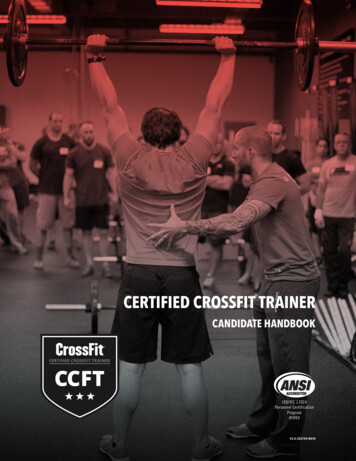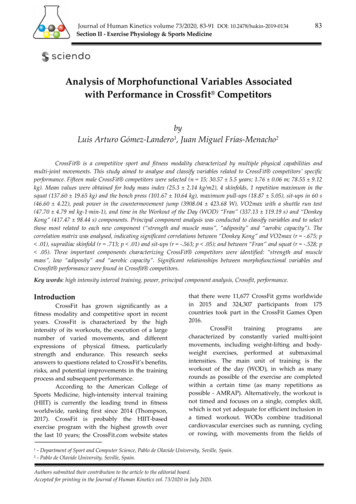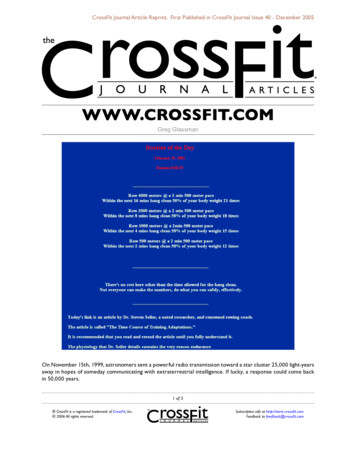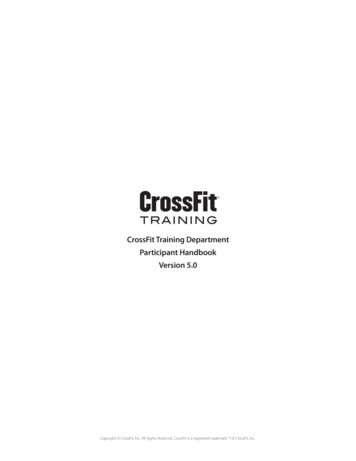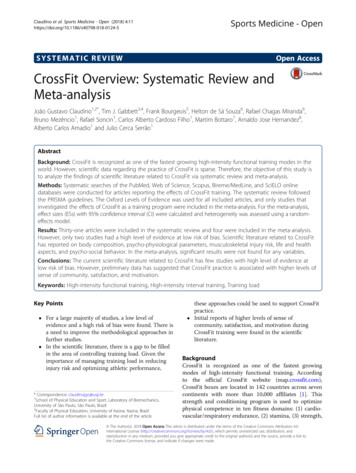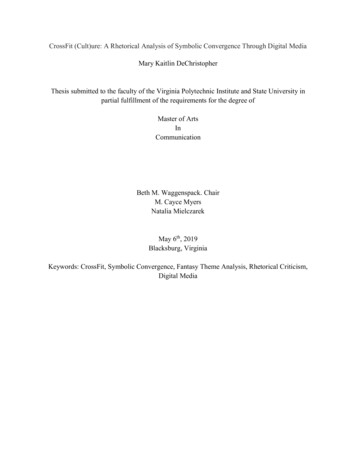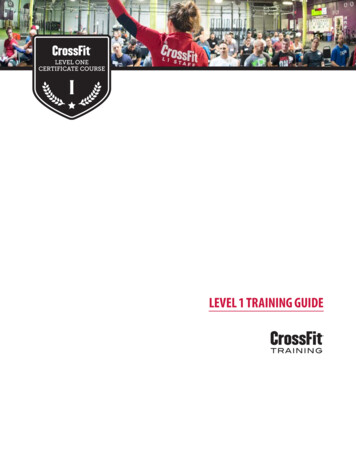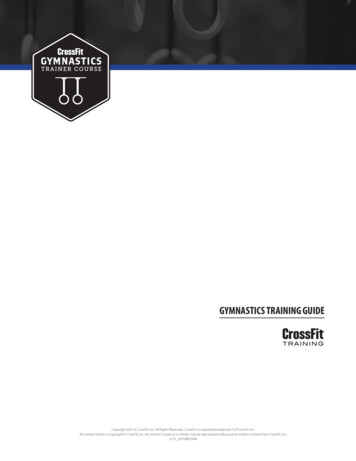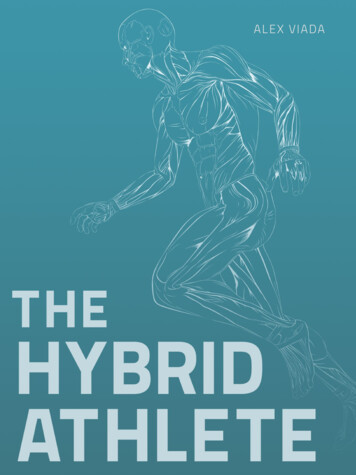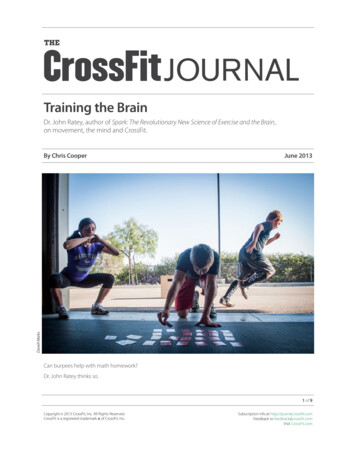
Transcription
THEJOURNALTraining the BrainDr. John Ratey, author of Spark: The Revolutionary New Science of Exercise and the Brain,on movement, the mind and CrossFit.June 2013Danell MarksBy Chris CooperCan burpees help with math homework?Dr. John Ratey thinks so.1 of 9Copyright 2013 CrossFit, Inc. All Rights Reserved.CrossFit is a registered trademark of CrossFit, Inc. Subscription info at http://journal.crossfit.comFeedback to feedback@crossfit.comVisit CrossFit.com
Brain .(continued)In 2008, the associate clinical professor of psychiatryat Harvard Medical School wrote the book Spark: TheRevolutionary New Science of Exercise and the Brain basedon the outstanding example of the Naperville SchoolBoard. The book summarized the experience of physicaleducation teacher Phil Lawler, who had implemented abefore-class fitness program at the Illinois school.“He threw out the balls. No more sports. Just getting fit:running, strength training, CrossFit-type activities forthe junior-high-school kids,” Ratey explained. “He hadthis brilliant idea to use heart-rate monitors, which wasa paradigm shift for phys. ed. Nineteen thousand kids inthe district and only 3 percent were obese. Seventy-fivehundred in the high schools and they couldn’t find a singleobese kid. Not one. So this was astounding.”Just as impressive: the school’s test scores.Andreane Fraser“Two years before I learned about it, they had participatedin the International Science and Math Test, which is givento every country in the world every three years. The U.S.is always in the low teens. The school district lobbied toparticipate as a country and came No. 1 in science andNo. 6 in math,” Ratey said. “The low obesity rate piqued myinterest. The test scores got me on a plane.”Ratey realized that lessons learned in Naperville couldhave a profound effect on education worldwide.“This was like magic. Boom: here’s my new mission in life.This was the glue that really led me to sit down and gothrough 1,000 articles and translate those into Spark,” hesaid.The book was an unqualified success and stirred thegelatinous bureaucracy of elementary-level academics.Many teachers, coaches and parents shared a collectiveepiphany: when kids run around more, they generally dobetter in school.Now Ratey is back with more. The learning experience canbe optimized, he said, and CrossFit might be the answer.“Miracle-Gro for the Brain”Andreane FraserSpark brought no surprises for Jeff and Mikki Martin, whocreated the CrossFit Kids program in 2007.Dr. John Ratey is convinced that physical activitycan improve brain function in young students.“In our gym early on—2004 to 2005—we started realizingthat kids who are more fit do better in school. Our GPAin the gym was above the average in the district, but noreal light bulbs went off. In 2006, we started realizing thatthis body of research was out there that brain function was2 of 9Copyright 2013 CrossFit, Inc. All Rights Reserved.CrossFit is a registered trademark of CrossFit, Inc. Subscription info at http://journal.crossfit.comFeedback to feedback@crossfit.comVisit CrossFit.com
Brain .(continued)influenced by exercise. In our gym, we had five valedictorians come out of the gym and two salutatorians,” Jeff said.“When the CrossFit Kids course was first delivered, Rateyand (Dr. John J.) Medina were foundational to the ideas wetaught. We brought their ideas into the course and talkedabout how we use study hall immediately following ourteen classes. We’ve been running that program for fouryears. The evidence is clear: There’s a window of opportunity to learn right after exercise.”Medina authored Brain Rules: 12 Principles for Survivingand Thriving at Work, Home, and School in 2008. He is thedirector of the Brain Center for Applied Learning Researchat Seattle Pacific University. A developmental molecularbiologist, Medina focuses his research on the genesinvolved in human brain development and the genetics ofpsychiatric disorders.“We started realizing thatthis body of research was outthere that brain function wasinfluenced by exercise.”—Jeff MartinCrossFit Kids is now involved in the curriculum for 400schools. And Ratey believes we’re just getting started.Andreane FraserThe core lesson taught in Ratey’s Spark was the neurochemical response to exercise. When we move, we secretea neurotropin called brain-derived neurotrophic factor,or BDNF, which helps make neural connections stronger.Ratey famously dubbed BDNF “Miracle-Gro for the brain.”Some CrossFit Kids workouts involve strategy, planning or even math, blurring the lines between classroom and gym.3 of 9Copyright 2013 CrossFit, Inc. All Rights Reserved.CrossFit is a registered trademark of CrossFit, Inc. Subscription info at http://journal.crossfit.comFeedback to feedback@crossfit.comVisit CrossFit.com
Brain .(continued)The Play AspectHarvard University’s campus isn’t immune to trends.Students matriculating at one of the world’s most prestigious schools still look and dress like kids anywhere else.But in the periphery, game-changing research is beingdriven by professors in mathematics, sciences, the artsand education. Much of this research will create trends forfuture study.Ratey’s office is the top floor of an old home converted intooffice space. A bookshelf sits below a small skylight, andcomfortable couches and chairs round out the domain of aman who has been interviewed often in the last five years.His speeches on TED stages have been viewed millions oftimes, he’s quoted weekly by news publications, and hisresearch has spawned thousands of academic papers.“After Spark came out, I began to speak all over and makeconnections with other Ph.D.s who were interested. Allof them read Spark and said, ‘This is really something:we’re lowering health-care costs, getting people moremotivated and fit but also keeping brains working better,more focused, less depressed, less stressed all thosethings we know that exercise does,” Ratey said. “I puttogether the science behind it to prove what we knewwas happening on the ground. That’s why it becameso popular. It led to studies here (at Harvard), there andeverywhere to look at how exercise really was impactingstudents and the elderly.”Although Spark’s focus was on students, he added, “Theelderly was the first area of interest in academic circlesbecause that’s where the money was, and preventingBoomers from developing Alzheimer’s is still an importantarea. Sixteen hundred papers were published last yearlooking at exercise’s effect on cognition. All were positivein the direction of preventing cognitive decline andAlzheimer’s disease. That’s pretty conclusive proof.”“CrossFit is great. It providesthe play aspect, certainly theexercise aspect, the connectionsand the small groups.”—Dr. John RateyCourtesy of Dr. John RateyIt’s not just the exercise. With so much new researchfocusing on learning, Ratey is widening the aperture toconsider elements beyond simply raising the heart rate.CrossFit, he said, is helping the brains of its athletes farbeyond increasing BDNF.Some of Dr. Ratey’s theories are based on speculationabout how our ancestors lived. Science has yet to revealeverything about early human history.Dr. Ratey’s book provided the science to explain the academicsuccess many educators were seeing in active children.“We got our genes when we were hunter-gatherers over100 million years ago. We were coded to move a lot, to4 of 9Copyright 2013 CrossFit, Inc. All Rights Reserved.CrossFit is a registered trademark of CrossFit, Inc. Subscription info at http://journal.crossfit.comFeedback to feedback@crossfit.comVisit CrossFit.com
Brain .(continued)play, to have the right kind of diet. To sleep. To have anexperience with nature because we weren’t living insidein those days. To have a mindfulness: a centerednessof who you are and where your being is. You had to beattentive or you’re cat food. We’re wired for these things.We’re genetically programmed to expect these things.Our brains perform at our optimum when we have thesethings involved. Then you have connection with anotherperson or a small family group,” Ratey said.“CrossFit is great. It provides the play aspect, certainly theexercise aspect, the connections and the small groups.When it’s possible, CrossFit classes go outside. They getan element of nature in there . All of these things arecritical to proper brain development.”Ratey will expand on each of these ideas in his forthcomingbook, Human 1.0, expected in 2014.The group ethos of CrossFit, he added, can help createbetter cognitive function.“We’re geared to be working in small tribes—everyone issupportive, moving together, pitching in, helping thoselagging behind to catch up. In hunter-gatherer times, youdidn’t want to leave anyone behind, because they hadto help out. You needed everybody’s participation,” Rateyexplained. “We’re genetically geared for that, and that’swhy I believe—what’s happening in our schools that aresuccessful—is they’re using small tribes. They’re usingtables instead of desks, working together in units. We’regenetically programmed to do that. We become suboptimal when we’re on our own.”Chris Cooper“One of the things someone said to me recently is, ‘We’rereally not born to run; the human person is like the SwissArmy knife.’ We have lots of different possibilities thatwe need to explore and develop physically as well ascognitively. CrossFit might be thought of as muscular, butit actually is so much more than that, and so I think that’sreally a big plus. I certainly have interviewed people for mynew book about how CrossFit has helped them, and it’sbeen remarkable for some people. The novelty of CrossFitWODs leads not just to greater interest but also challengesthe brain to develop more fully,” Ratey said.Ratey believes CrossFit’s constantly varied workouts and group training can create an environmentwhere kids can thrive mentally and physically.5 of 9Copyright 2013 CrossFit, Inc. All Rights Reserved.CrossFit is a registered trademark of CrossFit, Inc. Subscription info at http://journal.crossfit.comFeedback to feedback@crossfit.comVisit CrossFit.com
Brain .(continued)The Group EthosCrossFit’s SAT program, led by Laura Bradrick, is leveragingthe power of the tribe.“At this point, it’s gone beyond just SAT prep,” she said.“CrossFit gyms can help students—and adults—learnanything. Look at your members, find someone who lovesteaching. They might be a history or math teacher whoknows how to present material to kids. Look for a pianoteacher. If we can show them that whatever their specialtyis is worthwhile, it’s good. Who’s to say that being good atmath is more important than being good at piano?”Chris CooperBy incorporating exercise and academic tasks into onesession, students have the opportunity to shine amongtheir peers—even if they’re better with numbers than withthrusters.The group dynamic is also useful as a behavioraltransformer.“CrossFit gyms can help students—and adults—learn anything.”—Laura BradrickChris Cooper“It helps with modifying behavior because you want to bea member of the group, so you just can’t throw tantrumsall the time. You’ll be sat upon; the group can’t tolerateit. If you’re feeling depressed, they’ll want you not to bedepressed because they’re getting less of your activity,thoughts, participation, foraging, getting game—theycan’t have you that way. If you’re spooked too much,too anxious, depressed, panicky, they want that to settledown. The group demands that just by the ‘groupiness’ ofit,” Ratey said.Jeff Martin believes a CrossFit Kids group atmosphere canalso provide children with an opportunity to be leaders.“We have teens lead the ‘focus’ portion of the class for theyounger kids. They learn valuable public speaking withinthe class,” he said. “In the long run, the kids who do speakCrossFit’s SAT-prep program provides “above-the-neckfitness” that can help children get into the rights colleges.6 of 9Copyright 2013 CrossFit, Inc. All Rights Reserved.CrossFit is a registered trademark of CrossFit, Inc. Subscription info at http://journal.crossfit.comFeedback to feedback@crossfit.comVisit CrossFit.com
(continued)Chris CooperBrain .The brain is part of the body and can be trained just like the hamstrings can be trained to move greater loads.well publicly may get the better jobs because they canstand in front of a board and make a case for whateverthey want.”The group collaboration effect is powerful. But competition, Ratey noted, is just as important.“It’s natural. It’s in our genes. Look at being a good huntergatherer: you wanted the fastest one to finally get thedamn antelope. You needed that person to be the one tofinally make the kill, but you needed other people to chasethe antelope and wear him out so the sprinters could go inthere and make the kill,” he said. “There’s a need and naturaltendency for that competitiveness, but it can also be seenas something that leads the group or has a specific groupfunction. And so it’s not just the best athlete or greatestMudder or Spartan of the year. The smartest is as importantas the fastest.”Chris CooperThese specialties are best discovered through play, Rateysaid, and play is on the decline in schools. His email taglinereads, “It’s time to take play seriously.”Perhaps most importantly, CrossFit Kids makesfitness and learning fun.“Play helps you learn the social rules and emotionalregulation,” he continued. “We’re talking about interactiveplay. Sometimes you lose, but then you get up and do itagain because there’s an inherent feeling of it being fun.7 of 9Copyright 2013 CrossFit, Inc. All Rights Reserved.CrossFit is a registered trademark of CrossFit, Inc. Subscription info at http://journal.crossfit.comFeedback to feedback@crossfit.comVisit CrossFit.com
Brain .(continued)You also cheat and you learn that you’ll get exposed by thegroup, which is an important thing to learn. Physical interactive play teaches those lessons and also how to supportone another, how to get the most out of your group. Youwant everybody to be at their best. You don’t want peoplejust thinking about what’s straight ahead. You want peopleto think of new ideas and break the rules.”“You can’t come in with a package,” he said. “You haveto adapt it to every situation. There’s a lot of differentenvironments that are conducive to learning. The best issupportive, challenging, more ‘you can do it,’ more goaloriented. It shouldn’t come from just the teacher butthe students you’re participating with—more or less thegroup ethos.”Unstructured play, then, is critical for brain development.Transferring from the CrossFit Kids class to study hall carriesthe group approach from the physical to the academicrealm.“Recess may be as important as gym class,” Ratey said. “Ithink it’s really vital. People need to recognize that.”Recess also frequently takes children outside, anotherimportant element of learning.“Being in nature is very important,” he said. “It’s a wholechapter in the new book. Being outside helps to get thebrain ready to learn.”“I think all CrossFit gyms should have a classroom rightin there,” Martin said. “Other people have to argue withtheir kids to do their homework; ours do it because theyknow that’s what needs to be done. They don’t see hardwork in the same framework that other kids their age do.To develop correctly, we have to have obstacles and hardwork, and we have to overcome those obstacles.”“Recess may be as important asgym class. I think it’s really vital.People need to recognize that.”—Dr. John RateyIn Denmark, “outside schools” have children engaged inoutdoor education for the majority of their day. Kids comein for brief periods to use the washroom or change intodry clothes—an inverse of the traditional North Americanmodel. It begs the question: is more time outside better?“There’s no good study showing a minimum or maximumof any of these—aerobic activity, mindfulness, greentime—but I think the more, the better,” Ratey said. “Youcan have the weather to consider, and the capacity to shiftinside is probably more ideal.”Andreane FraserA Different Kind of ClassroomWhile Ratey doesn’t believe it’s possible to create aone-size-fits-all template for the perfect environment, hedoes see certain common elements.“I think all CrossFit gyms should have a classroomright in there.” —Jeff Martin8 of 9Copyright 2013 CrossFit, Inc. All Rights Reserved.CrossFit is a registered trademark of CrossFit, Inc. Subscription info at http://journal.crossfit.comFeedback to feedback@crossfit.comVisit CrossFit.com
Brain .(continued)While most research has students exercising before school,Ratey thinks we can do even more.“This morning, I visited a school in Lawrence, Mass. They’rethe worst school in the state, all these kids who speakEnglish as their second language,” he said. “They just starteda new program where they have P.E. twice per day. Beforelunch, they have a 30-minute recess break, so the kids get‘play’ time. Then class, lunch, another class, another recess,and then go home. They also have ‘brain breaks’—that’swhat I call them—where they do burpees or star jacks fortwo minutes in the middle of class. Two minutes makes adifference. They’re motivated, awake and aroused.”Bradrick said she’s heard of similar models in CrossFit gyms.“Some are doing CrossFit or CrossFit Kids and putting mathright into the workout,” she added.“Other people have to argue withtheir kids to do their homework;ours do it because they knowthat’s what needs to be done.”—Jeff MartinThis “intervention” idea is a popular one at CrossFit Catalystin Sault Sainte Marie, Ont. There, coach Tyler Belanger’sIgnite program shows teachers how to use “interventions”—short exercise breaks during class—to maintaina level of high engagement and arousal during class.Specialty programs like move-a-matics, drama, creativewriting and money matters are popular with children andparents.If a physical game involves a cognitive task, Ratey said, achild can get even greater benefit.“Your brain is on fire because it’s being used for the aerobicpart, but some parts are being asked to ‘search and switch,’”he said.And then there’s the burpee.“It is really one of the best exercises you can do for yourbrain. There’s plenty of evidence to show that aerobics isthe best exercise bang for your buck. But aerobics withsome coordination component—that’s probably the bestexercise you can do,” Ratey said. “If you want to constructthe ideal exercise, it’s this: something with someone else (apartner or small tribe) outside for up to 20 or 30 minutes. It’sfun, people are competing with one another and helpingone another. That is what we know from the evidence. Notjust running, but running in open spaces or playing gamesor doing physical challenges outside.”The implications of training the brain and body togetherreach far beyond the classroom.“The cerebellum—responsible for balance—is activatedwhen you activate the ‘core.’ The cerebellum is alsoinvolved with memory, learning, social skills, emotion andvery much with attention,” Ratey said. “All the learning skillsare very much involved with the cerebellum. We used tothink it was just about physical coordination, but it’s reallycoordinating all of our higher functions. If you are ‘discoordinated’ physically, some things are going to be out ofwhack intellectually and emotionally as well.”Ratey is using exercises—like burpees—that require interhemispheric coordination and recruitment of core musculature with a group of autistic students.“I’m setting up training to teach them coordination, andthis will have a payoff: being more focused, less aggressive,less self-destructive, more social. They are very uncoordinated—that’s a big problem. Their cerebellums are off.But you can train the cerebellum, which is what you’redoing all the time you’re working on the core exercises,”he said. “Even thinking of CrossFit, doing rowing—there’sa core component to that and certainly most of the otherexercises we do in a WOD. That’s training the cerebellum—it’s not just standing on one foot and doing the yoga pose,which is also great.”He added: “We don’t know all those constituents or partsof the puzzle, but we know that exercise can help. Beforeyou get into a retraining phase, using neurofeedback isessential.“Exercise will promote your ability to learn, plain andsimple.”FAbout the AuthorChris Cooper is a writer for CrossFit. He owns CrossFit Catalystin Sault Sainte Marie, Ontario.9 of 9Copyright 2013 CrossFit, Inc. All Rights Reserved.CrossFit is a registered trademark of CrossFit, Inc. Subscription info at http://journal.crossfit.comFeedback to feedback@crossfit.comVisit CrossFit.com
Spark brought no surprises for Jeff and Mikki Martin, who created the CrossFit Kids program in 2007. "In our gym early on—2004 to 2005—we started realizing that kids who are more fit do better in school. Our GPA in the gym was above the average in the district, but no real light bulbs went off. In 2006, we started realizing that
